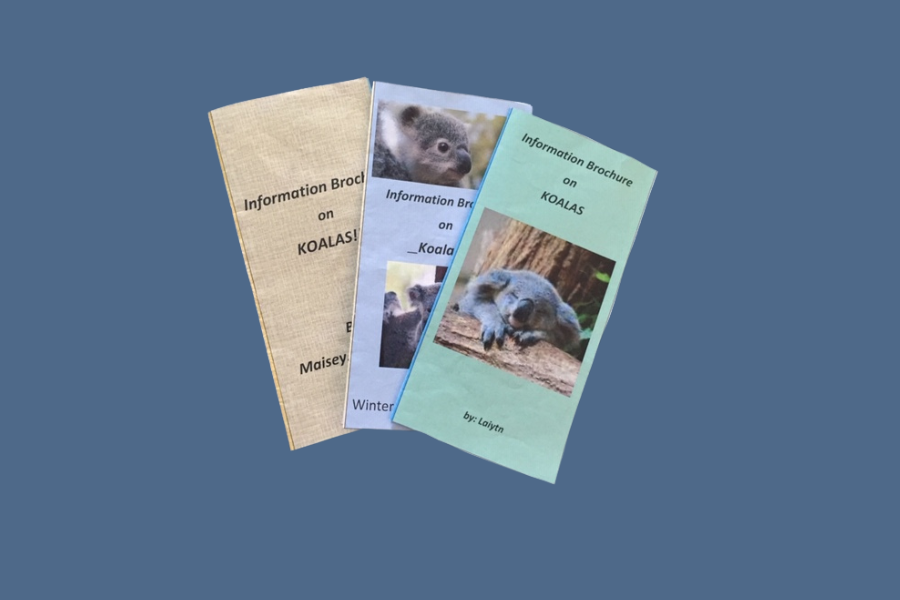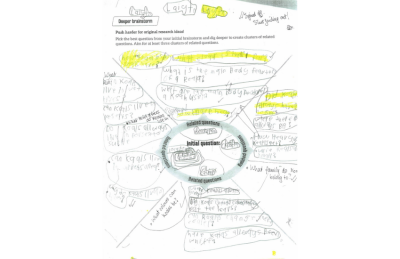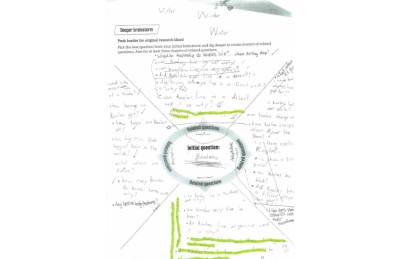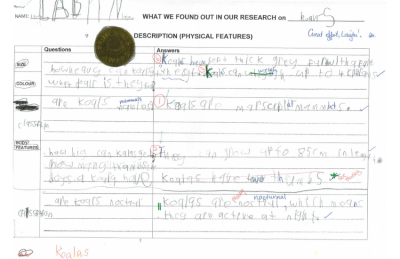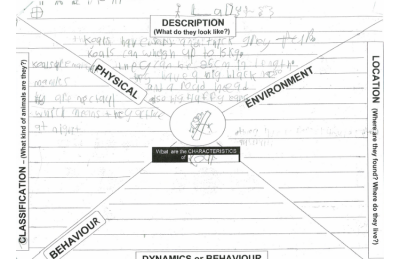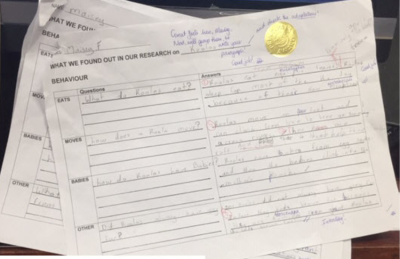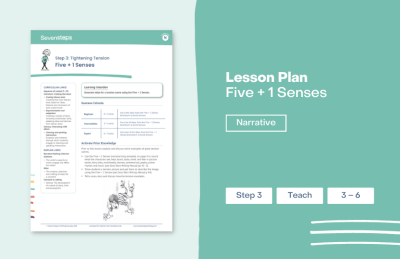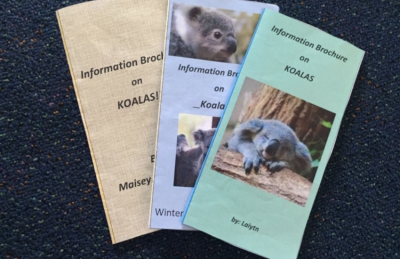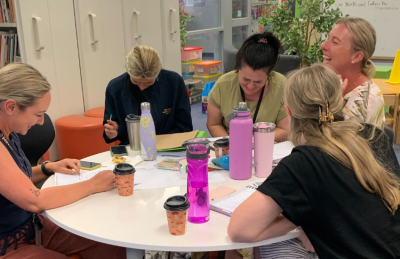No products in the cart.

8 min

Classroom Activities

Rebecca Hill
Giant fluffy bottoms.
Not a phrase you’d necessarily expect to see in an informative text, right?
At its essence, informative writing uses facts to educate the reader about a particular topic. But no one said it had to be sterile and stuffy.
Just take a look at this Sizzling Start to an informative text.
Imagine that you are walking through the bush and stumble across a eucalypt forest. The air tastes like tangy eucalypt oil. You see a grey dot in the eucalypt tree above you, dozing away and nestling into a beautiful big brown branch. You see a giant fluffy bottom.
How’s that for some seriously evocative imagery? You’re instantly transported to a thicket of scented gumtrees where, squinting up into the canopy, you catch sight of a koala. Bet you’re keen to read more!
Those charming word pictures were written by Maisey, a Year 3 student in Dawn Veary’s classroom at Margaret River Primary School. Dawn shared this wonderful example and her experience of using the techniques she learnt at Workshop Two: Putting It All Together.
Dawn had already begun an inquiry unit on Australian animals prior to the workshop but changed her approach after seeing the impact Seven Steps could have on students’ research and writing skills.
I was able to clearly see how to seamlessly integrate aspects of the information writing process into my school’s pedagogy of inquiry-based learning.

Dawn found that the tools and strategies she learnt from Workshop Two greatly impacted her students’ writing.
Students produced information brochures of a much higher calibre. The text flowed smoothly and incorporated narrative techniques in which they were well versed, such as word pictures, Sizzling Starts and Exciting Endings.
This forced them to dig deeper to express their findings in a more authentic and readable personal style. Both students and I were thrilled with the outcome.

Happy teacher; happy students. Tick!
But let’s take a step back to see exactly how Dawn took what she learnt in Workshop Two and ran with it.
Narrowing the focus
Students often don’t know where to begin with informative writing as the topic can seem overwhelming. So they tend to just cram in everything they know about a topic, which results in a boring list of regurgitated facts.
In Workshop Two, Dawn discovered that a double brainstorm was the key to:
- focusing in on an area of interest within the topic of study
- coming up with great questions as the basis for students’ research
- sourcing interesting facts that can be grouped to form cohesive sections in an informative text.
Dawn organised her class into groups of 3 who each chose their own Australian animal to research. Each member of the group was assigned one body paragraph to write.
First, they brainstormed everything they wanted to find out about their animal.
Then, Dawn did a deeper brainstorm with the class to narrow the focus and model how to develop open questions:
❎ Do koalas eat eucalyptus leaves?
✅ What do koalas eat?
Students then felt confident to work on their own deeper brainstorm – they could use some of the group questions but also came up with their own.
Laiytn and Winter both brainstormed their big questions about koalas before doing their research. This template is from the Workshop Two handout.
When it came time to start researching, students were fully engaged with the topic and motivated to find answers to their questions. Students recorded this information in dot points before writing fact statements in answer to each question.
Students recorded answers to deeper brainstorm questions using good sentences.
Dawn then conferenced with each group to help them plan their three body paragraphs before students got to work writing their assigned section using their own or other students’ fact statements. Dawn helped them select and order fact statements within each body paragraph to ensure cohesion and flow.
Dawn was confident in this process because she’d been through it herself in Workshop Two.
It was an incredibly valuable experience for me having to actively participate in the actual writing process in my break-out group. It gave me a huge insight into the stress created by time limitations and the trust you needed to place in your team as you collaborated, negotiating roles, etc. This guided my mentoring of my student groups back in the classroom.

Using mentor texts
Next up was writing a top and tail for the body text. Dawn used a mentor text to show students how to take the Sizzling Starts and Exciting Endings techniques they were already familiar with and use them in their informative writing.
Using mentor texts to model what good writing looks like takes the guesswork out for students. Reading the text aloud and discussing the language and techniques also helps students to think like authors when they come to write their own introduction and conclusion.

Dawn used the mentor text Coral Reefs by Seymour Simon to give students a clear understanding of what she was looking for.
For their start, students were encouraged to create a word picture based on the same sentence stem as the start of the mentor text: ‘Imagine you’re walking through the forest …’
They worked in groups to brainstorm some amazing imagery using the Five + 1 Senses activity, then worked alone to write their start. Dawn was blown away by what they came up with. ‘They’re so good at it’, she marvelled. ‘And it could work for any topic or inquiry unit.’
Five + 1 Senses
STEP Step 3: Tightening Tension
PURPOSE Teach
RESOURCE TYPE Lesson Plan
YEAR 3–6
For their ending, students were inspired by the same mentor text to include an impressive fact about their subject, express their emotional response to it and maybe even include a call to action.

Dawn used the same mentor text to inspire students when writing their Endings with Impact.
Working collaboratively
Collaborative work is a boon for writing – ideas flow and are built upon, and the load is shared.
In Dawn’s class, students were assigned one body paragraph each and then they wrote their own starts and endings to create a complete informative text. Because they have planned and researched the topic together, the finished text flows well and students learn from and feel supported by their peers.
Writing collaboratively was an amazing personal growth experience for all students. I had mixed ability groups and through this process, weaker students ‘stepped up’ to write stronger texts using the shared resources of information – and by feeling valued by the group and needing to produce a paragraph befitting the highest ability in the group, everybody’s writing lifted.

Celebrating student work
In the final stage of the process, students used a digital template to create an information brochure, typing in their own written section following the order on the plan, and their start and ending. They then personalised their brochure designs before printing them for display to share with parents and friends.
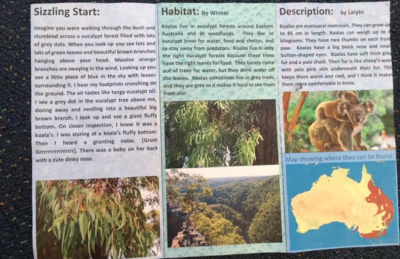
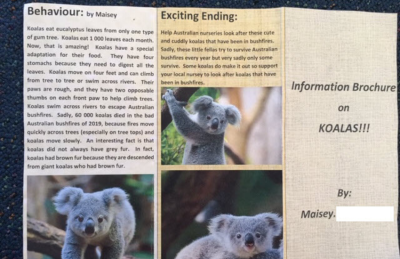
I will treasure the pride I saw on students’ faces, especially the weaker students in the group, as they looked through their brochures and saw their piece of writing (with their name attributed to it) in each finished brochure.

So … break the topic down, collaborate with others and get inspiration from real authors. These are some of the vital ingredients in the fuel that fires up next-level informative writing.
Want us to help you fire up your students’ informative writing?




